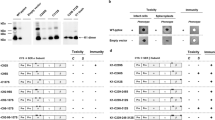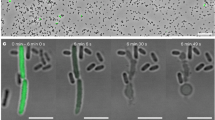Abstract
Yeast strains harboring M1-dsRNA and its packaging virus ScV-L secrete a disulfide-linked, heterodimeric toxin which kills sensitive yeast cells by disrupting plasma membrane function. The mature toxin is derived from a precursor (preprotoxin) which undergoes post-translational processing steps during export via the established yeast secretory pathway. Cleavage by both the KEX1 and KEX2 endopeptidases is required for expression of killing activity. The same 1.0 kb open reading frame on Ml-dsRNA directs the expression of immunity to toxin. Differentially processed derivatives of protoxin, as well as protoxin itself, have been proposed to serve as mediators of immunity.
To understand the mechanisms by which the killing and immunity phenotypes can be derived from a common precursor, we have: 1) studied cellular processes implicated in expression of the phenotypes; and 2) developed a system to produce mutants defective in immunity, killing, or both. In the first approach, the role played by both endocytosis and vesicular trafliking in expression of killing and immunity was examined. Strains defective in endocytosis (end1, end2) or vacuolar protein localization (vnp13, vp16) were transformed with a plasmid encoding killer toxin under control of the pho5 promoter. When induced by phosphate starvation, both end mutants and all vpl mutants expressed killing activity. Immunity to exogenous toxin, however, was significantly decreased in strains carrying both vpl mutant alleles and in one of the endocytosis mutants (end1)). This suicidal phenotype (rex for resistance expression) has been described previously in M1-containing strains as a leaky phenocopy. The distinct selective disadvantage of the rex phenotype can be overcome in this system by phosphate-mediated repression of killer toxin expression. In the second approach, a strain carrying the phosphate-repressible copy of the toxin gene was mutagenized with EMS, and survivors were scored for the rex phenotype. A large percentage of the rex mutants isolated also exhibited a vpl phenotype, implying that efficacious sorting of vacuolar proteins may be important for expression of immunity. In contrast, the rex mutants and the wild type REX + strain displayed an END + phenotype which was distinct from that of the end1 and end2 mutant. At the level of stringency of this fluid phase uptake assay, it appears that defective endocytosis is not a common phenotype obtained among independently isolated and viable rex mutants.
Similar content being viewed by others
References
Al-Aidroos K. and Bussey H. (1978): Chromosonal mutants of Saccharomyces cerevisiae affecting the cell wall binding site for killer factor. - Can. J. Microbiol., 24, 228–237.
Boone C., Bussey H., Greene D., Thomas D.Y. and Vernet T. (1986): Yeast killer toxin: site-directed mutations implicate the precursor protein as the immunity component. - Cell 46, 105–113.
Bostian K.A., Hopper J.E., Rogers D.T. and Tipper D.J. (1980): Translational analysis of the killer-associated virus-like particle dsRNA genome of S. cerevisiae: M1- dsRNA encodes toxin. - Cell 19, 404–414.
Bostian K.A., Elliot Q., Bussey H., Burn V, Smith A. and Tipper D.J. (1984): Sequence of the preprotoxin dsRNA gene of type 1 killer yeast: multiple processing events produce a two component toxin. -Cell 36, 741–751.
Bussey H., Saville D., Greene D., Tipper D.J. and Bostian K.A. (1983): Secretion of yeast killer toxin: processing of the glycosylated precursor. - Mol. Cell. Biol. 3, 1362–1370.
Bussey H., Steinmetz O. and Saville D. (1983): Protein secretion in yeast: two chromosomal mutants that oversecrete killer toxin in S. cerevisiae. - Curr. Genet. 7, 449–456.
Chou P.Y. and Fasman G.D. (1978): Prediction of the secondary structure of proteins from their amino acid sequence. - Ann. Rev. Biochem. 47, 251–276.
Chvatchko Y., Howald I. and Riezman H. (1986): Two yeast mutants defective in endocytosis are defective in pheromone response. - Cell 46, 355–364.
de la Pena P., Barros F., Gascon S., Lazo P.S. and Ramos S. (1981): The effect of yeast killer toxin on sensitive cells of Saccharomyces cerevisiae. -J. Biol. Chem. 256, 10420–10425.
Dmochowska A., Dignard D., Henning D., Thomas D.Y. and Bussey H. (1987): Yeast KEX1 gene encodes a putative protease with a carboxypeptidase B-like function involved in killer toxin and α-factor precursor processing. - Cell 50, 573–584.
Hanes S.D., Burn V.E., Sturley S.L., Tipper D.J. and Bostian K.A. (1986): Expression of a cDNA derived from the yeast killer preprotoxin gene: implications for processing and immunity. - Proc. Natl. Acad. Sci. USA 83, 1675–1679.
Hopper J.E., Bostian K.A., Rowe L.B. and Tipper D.J. (1977): Translation of the L-species dsRNA genome of the killer-associated virus-like particles of Saccharomyces cerevisiae. - J. Biol. Chem. 252, 9010–9017.
Joklik W.K. (1983): The Reoviridae. Fraenkel-Conrat H. and WagnerR., eds. Plenum Press N.Y.
Julius D., Brake A., Blair L., Kunisawa R. and Thorner J. (1984): Isolation of the putative structural gene for the lysine-arginine cleaving endopeptidase required for processing of yeast prepro-α-factor. - Cell 37, 1075–1089.
Lolle S.J. and Bussey H. (1986): In vivo evidence for signal cleavage of the killer preprotoxin of Saccharomyces cerevisiae. - Mol. Cell. Biol. 6, 4274–4280.
Makower M. and Bevan E.A. (1963): The physiological basis of the killer character in yeast. - Proc. Int. Congr. Genet. XI, 1, 202.
Rothman J.H. and Stevens T.H. (1986): Protein sorting in yeast: mutants defective in vacuole biogenesis mislocalize vacuolar proteins into the late secretory pathway. - Cell 47, 1041–1051.
Sturley S.L., Elliot Q.E., LeVitre J., Tipper D.J. and Bostian K.A. (1986): Mapping of functional domains within the Saccharomyces cerevisiae type 1 killer preprotoxin. - EMBO J. 5, 3381–3389.
Sturley S.L., Le Vitre J., Tipper D.J. and Bostian K.A. (1988): Maturation of type 1 killer preprotoxin of Saccharomyces cerevisiae and the expression of the immunity phenotype. Manuscript in preparation.
Sturley S.L. Palmer J.D., Douglas C.M. and Bostian K.A. (1988): Endocytosis and vacuolar protein localization are required for the expression of immunity to type 1 killer toxin in Saccharomyces cerevisiae. Manuscript in preparation.
Sturley S.L., El-Sherbeini M., Kho S.H., LeVitre J. and Bostian K.A. (1988): in Viruses of Fungi and Simple Eucaryotes. eds. Leibowitz M.J. and Koltin I., Marcel Dekker. - Inc., New York, pp. 179–208.
Thrash C., Voelkel K., Dinardo S. and Sternglanz R. (1984): Identification of Saccharomyces cerevisiae mutants deficient in DNA topoisomerase I activity. -J. Biol. Chem. 259, 1375–1377.
Tipper D.J. and Bostian K.A. (1984). Double-stranded ribonucleic acid killer systems in yeasts. - Microbiol. Rev. 48, 125–156.
Wickner R.B. and Leibowitz M.J. (1976): Two chromosomal genes required for killer expression in killer strains of Saccharomyces cerevisiae. Genetics, 82, 429–442.
Wickner R.B., Ridley S.P., Fried H., Ball S.G. (1982): Ribosomal protein L3 is involved in replications or maintenance of the killer double-stranded RNA genome of Saccharomyces cerevisiae. Proc. Natl. Acad. Sci. USA 79, 4706–4708.
Wickner R.B. (1986): Double-stranded RNA replication in yeast: the killer system. Ann. Rev. Biochem. 55, 373–395.
Author information
Authors and Affiliations
Rights and permissions
About this article
Cite this article
Douglas, C.M., Sturley, S.L. & Bostian, K.A. Role of protein processing, intracellular trafficking and endocytosis in production of and immunity to yeast killer toxin. Eur J Epidemiol 4, 400–408 (1988). https://doi.org/10.1007/BF00146389
Issue Date:
DOI: https://doi.org/10.1007/BF00146389




